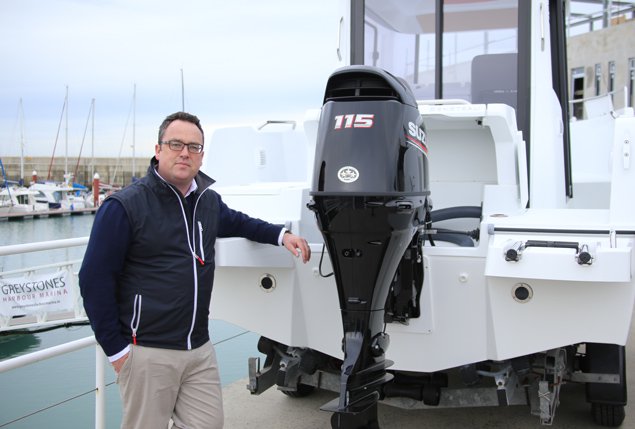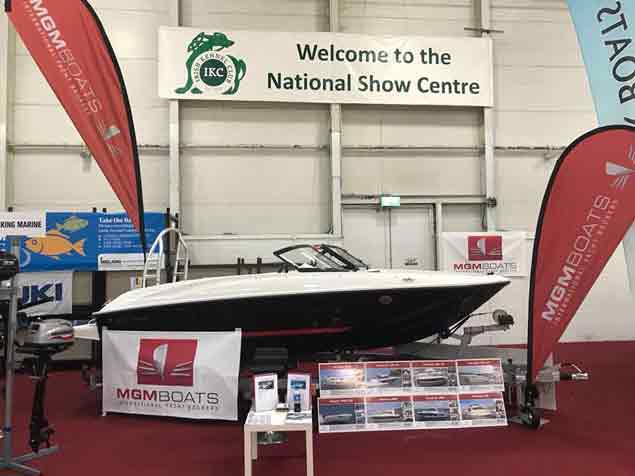Displaying items by tag: Bayliner
Did Angling Show Mark the Return of New Boat Sales to Ireland?
Irish boat sales firms will be eagerly anticipating a return to better times after a spate of interest from dealers in an early season consumer exhibition in Dublin.
A north Dublin Angling show, held last weekend, witnessed the start of a return of new motor boat sales in this country after a decade of little or no new boat sales activity.
A mix of Raider, Warrior, Beneteau and Bayliner marques up to 19–feet in length went on display, representing the new home market in this category.
BJ Marine from Greystones Marina billed the show at Cloghran as the venue for the 'UK and Ireland debut' of Beneteau's Barracuda 6 fishing boat, a new model with fixed doors and an enclosed wheelhouse.
 BJ Marine's James Kirwan with one of the new Beneteau Barracuda 6 Sport fishing boats fitted with a 115hp Suzuki outboard engine, now in stock at its Greystones Harbour Marina base Photo: Afloat.ie
BJ Marine's James Kirwan with one of the new Beneteau Barracuda 6 Sport fishing boats fitted with a 115hp Suzuki outboard engine, now in stock at its Greystones Harbour Marina base Photo: Afloat.ie
 MGM's new Bayliner Element E5
MGM's new Bayliner Element E5
Rival dealer MGM Boats were also at the Show, and they too were debuting a new model of similar size, a multi–use powerboat, the Bayliner Element E5.
There was a strong presence from Suzuki Outboard engines too with its Irish dealer Viking Marine also exhibiting as Afloat.ie reported here.
There has been no Irish Boat show at the traditional RDS venue in nine years and, until now, there has been little demand for same.
Few dealers have been carrying any stock to speak of and the 'marine high street' has been a lot less exotic than it was in, say 2006 at the height of the boom, when Irish Marine Federation members filled the RDS Simmonscourt Halls with over 100 exhibitors in one of the largest ever consumer exhibitions held in Ireland.
'It was great to be exhibiting at a domestic show again, complementing our usual international shows. We had huge numbers on board our Barracuda 6 and people loved the concept of the boat and the range. Plenty to follow up on this week but we would be very confident that there will be more new Beneteau Barracudas in Ireland as a result of the show', BJ Marine's James Kirwan told Afloat.ie
Last weekend in Cloghran may have been a long way from those heady days but from small acorns grow mighty oaks. The hope must be that with an improving economy the Irish marine trade can now get back on its feet after a torrid few years at home.
MGM Boats Open in Cork
As part of ongoing plans to expand its brokerage service (and promote the ranges of Sunseeker, Aquador and Bayliner Boats) MGM Boats Ltd of Dun Laoghaire is opening a new sales office on the waters edge, at Pier road, Kinsale. The office is expected to open by the End of February. "We have invested heavily in our Brokerage Department over the past two years resulting in a steady increase of Boat owners submitting their boat to us for sale" says MGM's Martin Salmon.
The Dun Laoghaire firm also has bases on Strangford, the Shannon and the English South Coast in Hamble. Salmon says the firm currently has 'tremendous value to offer the Cork boaters in quality used sportsboats, sailboats and motor cruisers'. In spite of the hard-times the award winnig dealership says it is looking forward to a 'prosperous season' on the south coast.
Kinsale is a leading sailing port in Ireland and this year the town and local yacht club hosts one of the biggest events of the Irish sailing calendar, the Sovereigns Cup in June.






























































